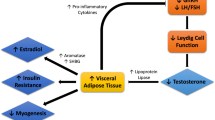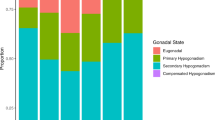Abstract
Male hypogonadism has a multifactorial etiology that includes genetic conditions, anatomic abnormalities, infection, tumor, and injury. Defects in the hypothalamic-pituitary-gonadal axis may also result from type II diabetes mellitus and treatment with a range of medications. Circulating testosterone levels have been associated with sexual function, cognitive function, and body composition. Apart from reduced levels of testosterone, clinical hallmarks of hypogonadism include absence or regression of secondary sex characteristics, reduced fertility (oligospermia, azoospermia), anemia, muscle wasting, reduced bone mass (and bone mineral density), and/or abdominal adiposity. Some patients, particularly those with partial androgen deficiency of the aging male, also experience sexual dysfunction, reduced sense of vitality, depressed mood, increased irritability, difficulty concentrating, and/or hot flushes in certain cases of acute onset. As many patients with male hypogonadism—like patients with erectile dysfunction—do not seek medical attention, it is important for clinicians to be acquainted with the signs and symptoms of hypogonadism, and to conduct appropriate laboratory testing and other assessments to determine the causes and inform the treatment of this condition.
This is a preview of subscription content, access via your institution
Access options
Subscribe to this journal
Receive 8 print issues and online access
$259.00 per year
only $32.38 per issue
Buy this article
- Purchase on Springer Link
- Instant access to full article PDF
Prices may be subject to local taxes which are calculated during checkout
Similar content being viewed by others
References
Rhoden EL, Morgentaler A . Risks of testosterone-replacement therapy and recommendations for monitoring. N Engl J Med 2004; 350: 482–492.
American Association of Clinical Endocrinologists. Medical Guidelines for Clinical Practice for the Evaluation and Treatment of Hypogonadism in Adult Male Patients: 2002 update. Endocr Pract 2002; 8: 440–456.
Hameed A, Brothwood T, Bouloux P . Delivery of testosterone replacement therapy. Curr Opin Invest Drugs 2003; 4: 1213–1219.
Rehman J, Melman A . Pathophysiology of erectile dysfunction. In: Lue TF, Goldstein M, Vaughan Jr ED, Perlmutter AP, (eds.), Impotence and Infertility. Atlas of Clinical Urology vol. 1, Philadelphia, PA: Current Medicine, Inc., 1999, pp. 1.1–1.16.
Morley JE, Melmed S . Gonadal dysfunction in systemic disorders. Metabolism 1979; 28: 1051–1073.
Bhasin S, Woodhouse L, Casaburi R, Singh AB, Bhasin D, Berman N et al. Testosterone dose–response relationships in healthy young men. Am J Physiol Endocrinol Metab 2001; 281: E1172–E1181.
Woodhouse LJ, Gupta N, Bhasin M, Singh AB, Ross R, Phillips J et al. Dose-dependent effects of testosterone on regional adipose tissue distribution in healthy young men. J Clin Endocrinol Metab 2004; 89: 718–726.
Kelleher S, Conway AJ, Handelsman DJ . Blood testosterone threshold for androgen deficiency symptoms. J Clin Endocrinol Metab 2004; 89: 3813–3817.
Vermeulen A . Androgen replacement therapy in the aging male: a critical evaluation. J Clin Endocrinol Metab 2001; 86: 2380–2390.
King BE, Packard MG, Alexander GM . Affective properties of intra-medial preoptic area injections of testosterone in male rats. Neurosci Lett 1999; 269: 149–152.
Mills TM, Reilly CM, Lewis RW . Androgens and penile erection: a review. J Androl 1996; 17: 633–638.
Baba K, Yajima M, Carrier S, Morgan DM, Nunes L, Lue TF et al. Delayed testosterone replacement restores nitric oxide synthase-containing nerve fibres and the erectile response in rat penis. BJU Int 2000; 85: 953–958.
Reilly CM, Stopper VS, Mills TM . Androgens modulate the α-adrenergic responsiveness of vascular smooth muscle in the corpus cavernosum. J Androl 1997; 18: 26–31.
Vernet D, Cai L, Garban H, Babbitt ML, Murray FT, Rajfer J et al. Reduction of penile nitric oxide synthase in diabetic BB/WORdp (type I) and BBZ/WORdp (type II) rats with erectile dysfunction. Endocrinology 1995; 136: 5709–5717.
Traish AM, Munarriz R, O'Connell L, Choi S, Kim SW, Kim NN et al. Effects of medical or surgical castration on erectile function in an animal model. J Androl 2003; 24: 381–387.
Carani C, Scuteri A, Marrama P, Bancroft J . The effects of testosterone administration and visual erotic stimuli on nocturnal penile tumescence in normal men. Horm Behav 1990; 24: 435–441.
Lugg JA, Rajfer J, Gonzalez-Cadavid NF . Dihydrotestosterone is the active androgen in the maintenance of nitric oxide-mediated penile erection in the rat. Endocrinology 1995; 136: 1495–1501.
Davidson JM, Kwan M, Greenleaf WJ . Hormonal replacement and sexuality in men. Clin Endocrinol Metab 1982; 11: 599–623.
Becker AJ, Uckert S, Stief CG, Scheller F, Knapp WH, Hartmann U et al. Cavernous and systemic testosterone plasma levels during different penile conditions in healthy males and patients with erectile dysfunction. Urology 2001; 58: 435–440.
Hooven CK, Chabris CF, Ellison PT, Kosslyn SM . The relationship of male testosterone to components of mental rotation. Neuropsychologia 2004; 42: 782–790.
Christiansen K, Knussmann R . Sex hormones and cognitive functioning in men. Neuropsychobiology 1987; 18: 27–36.
Alexander GM, Swerdloff RS, Wang C, Davidson T, McDonald V, Steiner B et al. Androgen–behavior correlations in hypogonadal men and eugonadal men. II. Cognitive abilities. Horm Behav 1998; 33: 85–94.
Sih R, Morley JE, Kaiser FE, Perry III HM, Patrick P, Ross C . Testosterone replacement in older hypogonadal men: a 12-month randomized controlled trial. J Clin Endocrinol Metab 1997; 82: 1661–1667.
Janowsky JS, Oviatt SK, Orwoll ES . Testosterone influences spatial cognition in older men. Behav Neurosci 1994; 108: 325–332.
Ramsden M, Nyborg AC, Murphy MP, Chang L, Stanczyk FZ, Golde TE et al. Androgens modulate β-amyloid levels in male rat brain. J Neurochem 2003; 87: 1052–1055.
Ramsden M, Shin TM, Pike CJ . Androgens modulate neuronal vulnerability to kainate lesion. Neuroscience 2003; 122: 573–578.
Ready RE, Friedman J, Grace J, Fernandez H . Testosterone deficiency and apathy in Parkinson's disease: a pilot study. J Neurol Neurosurg Psychiatry 2004; 75: 1323–1326.
Kenny AM, Fabregas G, Song C, Biskup B, Bellantonio S . Effects of testosterone on behavior, depression, and cognitive function in older men with mild cognitive loss. J Gerontol A Biol Sci Med Sci 2004; 59: 75–78.
Barrett-Connor E, Von Muhlen DG, Kritz-Silverstein D . Bioavailable testosterone and depressed mood in older men: the Rancho Bernardo Study. J Clin Endocrinol Metab 1999; 84: 573–577.
Rabkin JG, Wagner GJ, McElhiney MC, Rabkin R, Lin SH . Testosterone versus fluoxetine for depression and fatigue in HIV/AIDS: a placebo-controlled trial. J Clin Psychopharmacol 2004; 24: 379–385.
Seidman SN, Spatz E, Rizzo C, Roose SP . Testosterone replacement therapy for hypogonadal men with major depressive disorder: a randomized, placebo-controlled clinical trial. J Clin Psychiatry 2001; 62: 406–412.
Pope Jr HG, Cohane GH, Kanayama G, Siegel AJ, Hudson JI . Testosterone gel supplementation for men with refractory depression: a randomized, placebo-controlled trial. Am J Psychiatry 2003; 160: 105–111.
Carnahan RM, Perry PJ . Depression in aging men: the role of testosterone. Drugs Aging 2004; 21: 361–376.
Morley JE, Perry III HM, Kaiser FE, Kraenzle D, Jensen J, Houston K et al. Effects of testosterone replacement therapy in old hypogonadal males: a preliminary study. J Am Geriatr Soc 1993; 41: 149–152.
Buena F, Swerdloff RS, Steiner BS, Lutchmansingh P, Peterson MA, Pandian MR et al. Sexual function does not change when serum testosterone levels are pharmacologically varied within the normal male range. Fertil Steril 1993; 59: 1118–1123.
Valimaki VV, Alfthan H, Ivaska KK, Loyttyniemi E, Pettersson K, Stenman UH et al. Serum estradiol, testosterone, and sex hormone-binding globulin as regulators of peak bone mass and bone turnover rate in young Finnish men. J Clin Endocrinol Metab 2004; 89: 3785–3789.
Rucker D, Ezzat S, Diamandi A, Khosravi J, Hanley DA . IGF-I and testosterone levels as predictors of bone mineral density in healthy, community-dwelling men. Clin Endocrinol (Oxford) 2004; 60: 491–499.
Abbasi AA, Drinka PJ, Mattson DE, Rudman D . Low circulating levels of insulin-like growth factors and testosterone in chronically institutionalized elderly men. J Am Geriatr Soc 1993; 41: 975–982.
Herbst KL, Bhasin S . Testosterone action on skeletal muscle. Curr Opin Clin Nutr Metab Care 2004; 7: 271–277.
van den Beld AW, de Jong FH, Grobbee DE, Pols HA, Lamberts SW . Measures of bioavailable serum testosterone and estradiol and their relationships with muscle strength, bone density, and body composition in elderly men. J Clin Endocrinol Metab 2000; 85: 3276–3282.
Baumgartner RN, Waters DL, Gallagher D, Morley JE, Garry PJ . Predictors of skeletal muscle mass in elderly men and women. Mech Ageing Dev 1999; 107: 123–136.
Verhaar HJJ, Samson MM, Aleman A, de Vries WR, de Vreede PL . The relationship between indices of muscle function and circulating anabolic hormones in healthy men. Aging Male 2000; 3: 75–80.
Lue TF, Giuliano F, Montorsi F, Rosen RC, Andersson K-E, Althof S et al. Summary of the recommendations on sexual dysfunctions in men. J Sex Med 2004; 1: 6–23.
Bremner WJ, Vitiello MV, Prinz PN . Loss of circadian rhythmicity in blood testosterone levels with aging in normal men. J Clin Endocrinol Metab 1983; 56: 1278–1281.
Snyder PJ . Hypogonadism in elderly men: what to do until the evidence comes. N Engl J Med 2004; 350: 440–442.
Conway AJ, Handelsman DJ, Lording DW, Stuckey B, Zajac JD . Use, misuse and abuse of androgens: The Endocrine Society of Australia consensus guidelines for androgen prescribing. Med J Aust 2000; 172: 220–224.
Mohr BA, Guay AT, O'Donnell AB, McKinlay JB . Normal, bound and nonbound testosterone levels in normally ageing men: results from the Massachusetts Male Ageing Study. Clin Endocrinol 2005; 62: 64–73.
Author information
Authors and Affiliations
Corresponding author
Rights and permissions
About this article
Cite this article
Seftel, A. Male hypogonadism. Part II: etiology, pathophysiology, and diagnosis. Int J Impot Res 18, 223–228 (2006). https://doi.org/10.1038/sj.ijir.3901365
Received:
Accepted:
Published:
Issue Date:
DOI: https://doi.org/10.1038/sj.ijir.3901365
Keywords
This article is cited by
-
The COVID-19 pandemic — what have urologists learned?
Nature Reviews Urology (2022)
-
Surgically induced weight loss effects on sexual quality of life of obese men: a prospective evaluation
Surgical Endoscopy (2020)
-
Content Validity of the Hypogonadism Impact of Symptoms Questionnaire (HIS-Q): A Patient-Reported Outcome Measure to Evaluate Symptoms of Hypogonadism
The Patient - Patient-Centered Outcomes Research (2016)
-
Androgens, body fat Distribution and Adipogenesis
Current Obesity Reports (2014)



